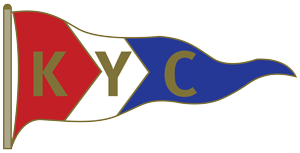Purpose
- To allow 3 boats per mooring (25 knots operating allowance) to remain moored outside KYC over night.
Requirements
- Boats require anchor lights.
- No more than 3 boats per morroing @ 25 knots
- Operational only under 30 knots
Notes:
1. What daily checks are recommended?
Check for chafe on the float and mainline loop. If the wind has swung more than approx. 90 degrees it is wise to have a swimmer go down and ensure the anchor has aligned with the new wind direction, if it has not the swimmer can lift the anchor and re-align to avoid bending the shank or having the anchor dislodge.
2. Recommended operating limits?
There are no fixed guidelines. A lot depends on how large and how many boats are hanging of each of the 5 x anchors, At 30 knots of breeze I would personally limit to 1 x boat per anchor maximum of 2. Anything more than 30+ bring the boats ashore even though in reality 1 x 8+m boat on that sort of anchor system should weather at least 45 knots and solid seas.
3.Operating use overview
When laying the anchors and chains ensure the anchor is lowered in a controlled fashion so the head of the anchor touches the bottom first with the shank and chain following whilst being laid in a straight line as close to downwind as possible.
The boat lowering the anchor should be moving backwards slowly directly downwind.
Once the anchor and all of the chain are on the bottom and you are at the loop at the end of the main warp, have the boat reverse to set the anchor, it should be very obvious if the anchor is set well and holding, if not repeat the laying process.
The biggest risk with tying up to the main anchor line is chafe, all attempts to avoid chafe should be taken.
If a painter of the boat is tied directly to/through the loop in the mainline/rode, then ideally it should have a large shackle to avoid a rope to rope loop because of the high chafe potential. A large shackle avoids this. When the anchor sets where ordered there was a request to slice a large thimble in the mainline loop to avoid this chafe issue, it did not happen unfortunately.
If the main line/rode is looped directly over a solid cleat on the lead boat, chafe is normally reduced to a minimum but care should be taken to ensure the mainline/rode rope is not going over objects likely to chafe, this is not normally an issue with RIBS.
It is always good to tie off the float line with some slack in it as a secondary/backup so if for some reason the mainline attachment fails the float line should hold the boat, at least for some time.
During JSA additional boats were tied to the stern of the boat ahead with approximately 3 metres distance between the bow and stern of each boat. We only did 3 per mooring due to a forecast upwards of 25 knots.
This system works OK but relies on each boat tying up correctly and no breakages, if the lead boat breaks off all boats end up drifting away.
We are working on a backbone system for the Opti nationals where each boat is tied directly to the backbone, this way boats can leave any time and if the tying of one boat fails then they all do not drift away. See attached sketch of the proposed system.
When laying the anchors they need to be spaced far enough apart to account for the number of boats/length of boats hanging of each, if 5 boats as per the attached sketch then say outside a 50m minimum radius.
I am not a big fan of rafting boats side by side unless the conditions are calm, rafting boats side by side increases windage and drag on the anchor set, there are also high boat to boat chafe issues.
Retrieving the anchors can be done by one old man such as myself so not difficult, just a bit of a grunt.
It is good to ensure damage does not occur to the inflatable fender of the boat launching and retrieving the anchors, some form of canvas cover would help and make the job easier on the person doing the hauling.
4. Night anchoring lights?
Always good to check that people have tied their boats off well, I cannot emphasize how important this is for obvious reasons. If the lead boat is not tied off properly all boats drift away, not good.
Onus should be put on the owners of the boats to ensure their own boat is tied off correctly as well as check the boats up stream of theirs. (The mainline/backbone system gets around the upstream problem)
Yes, technically a 360 degree visible white light is required on each boat. KYC has 6 x LED camping lanterns that worked perfectly well. These were tied or taped high on the consoles of the lead boat.
If the string of boats is much more than 3, I suggest more lights should be used.
5. Boat “engine key” procedure for overnight security
During JSA the keys where left aboard. It was seen as a major to administer keys and there could be an argument to say leaving the keys aboard would help someone operate the boat out of harm’s way should it be found adrift. FYI the boats left on the beach also had their keys left in the ignition, no problems but we may have been lucky.
6. Were there any system debrief improvements recommended to enhance the system?
Nil



